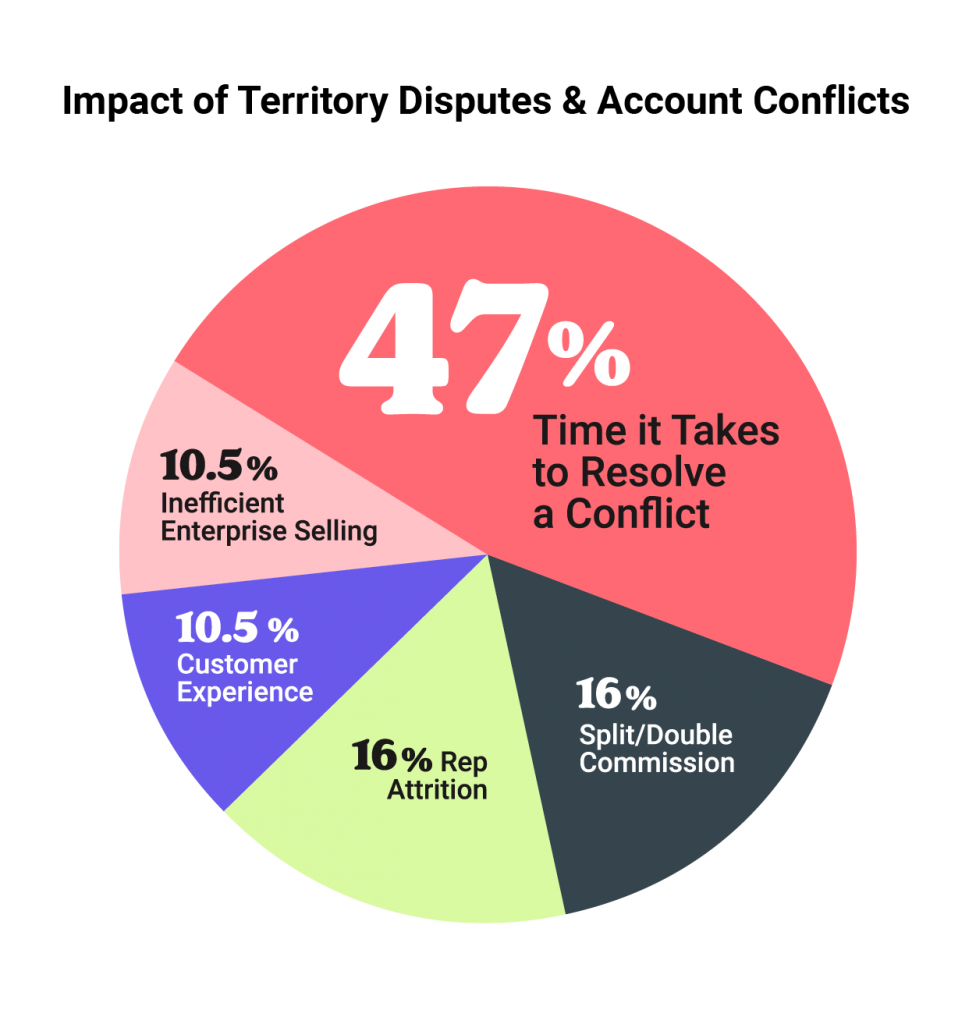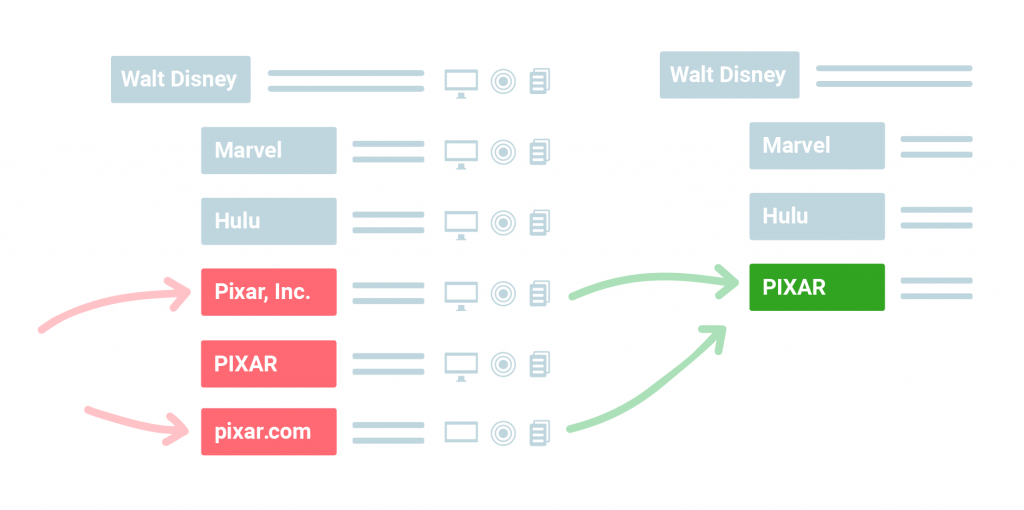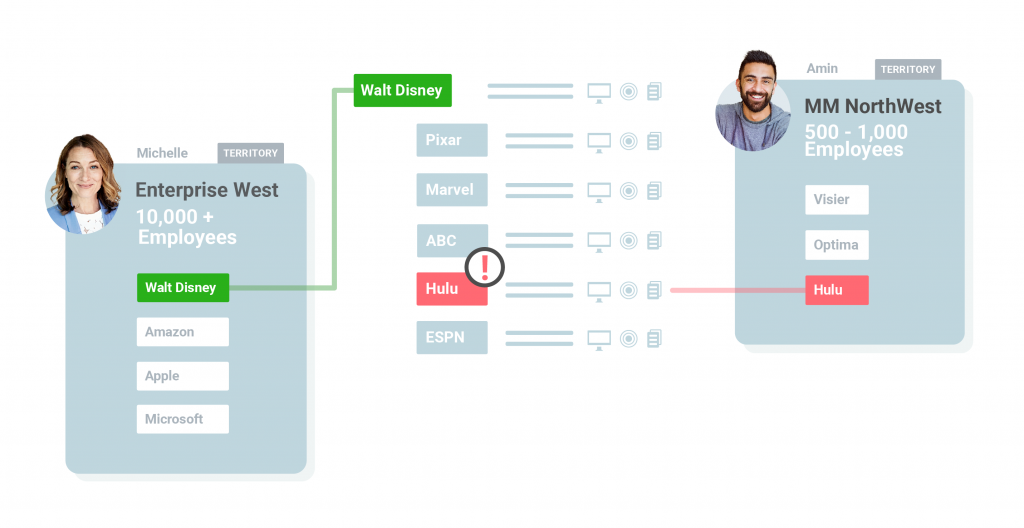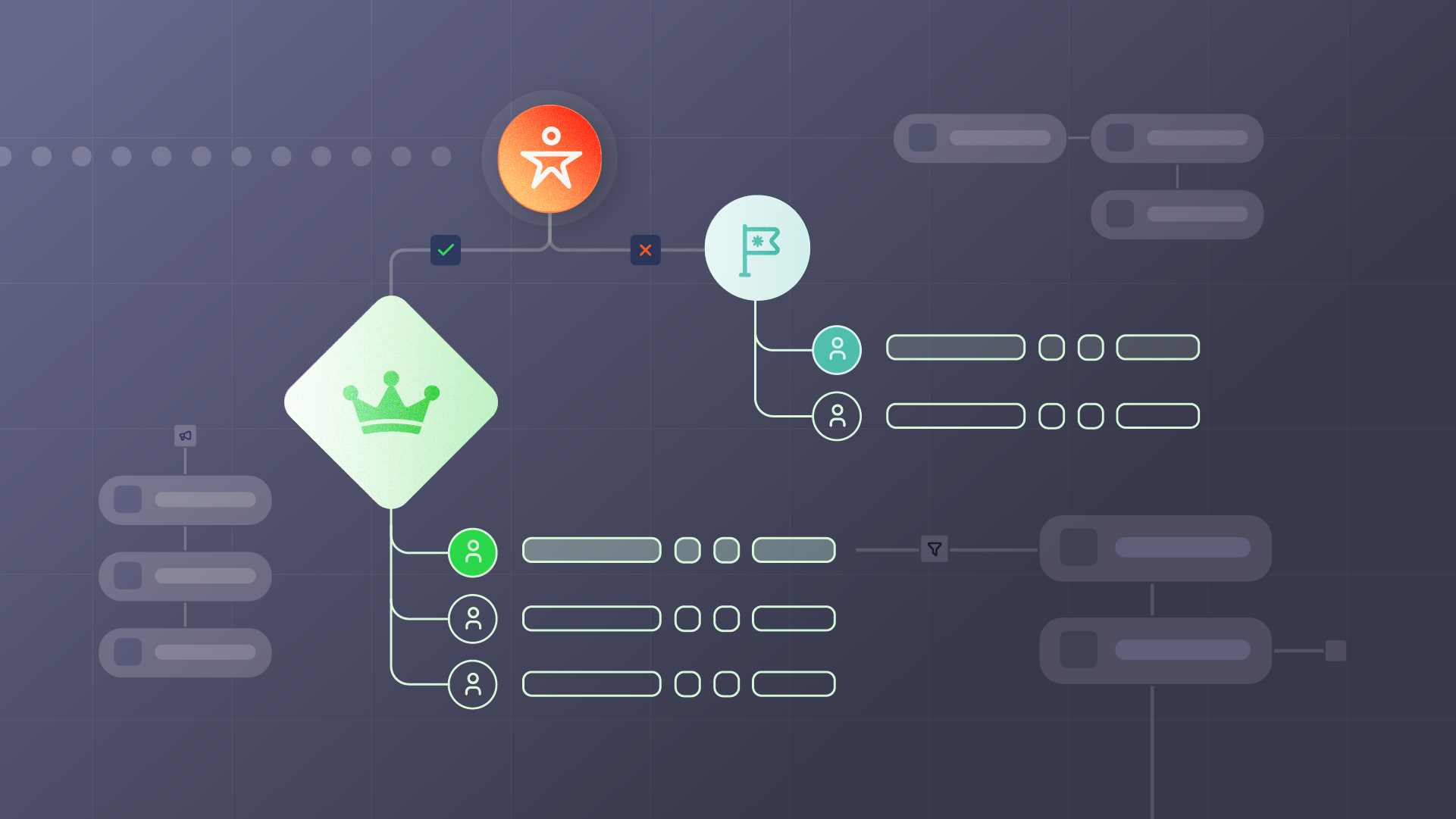Chaos to Calm: 5 Tactics to Avoid Account Conflicts
Studies show that up to 30% of a typical manager’s time is spent dealing with conflict.
When it comes to your sales motions, how much time does your team spend navigating territory disputes and account conflicts? Imagine if you could channel that time into revenue instead.
Territory disputes and account conflicts negatively affect sales teams’ efficiency, morale, and ultimately as a result, revenue. A single conflict involves multiple parties and holds back teams from spending time doing what they do best – selling.
There’s no shortage of impacts that territory disputes have on sales ops teams either. Here are the most pressing impacts that attendees called out in our recent webinar, “5 Tactics To Avoid Territory Disputes With Account Hierarchies”:
- 47% time it takes to resolve a conflict
- 16% rep attrition
- 16% commission splits
- 10.5% inefficient selling
- 10.5% customer experience

If you’re looking to take territory dispute management from a state of conflict to calm, it’s time to start addressing your account conflicts at the source of the problem. Let’s look at how automated account hierarchies can help reduce account conflicts by up to 80%, increase revenue, and retain sales reps.
Where do account conflicts stem from?
The biggest hidden culprit? Dirty data.
There are a lot of data-related factors that contribute to account conflicts, but the biggest offenders are missing parent-child account data, duplicate records and a lack of data governance.
Combine this with organizational factors like policy execution, lack of communication, and siloed teams and you have a recipe for inefficiency. And this isn’t just a territory problem.
Dirty data in your CRM can cost $100 per dirty record, according to Sirius Decisions.
When companies have upward of thousands or millions of records, that’s a whole lot of dirty dough.
Very few organizations have 100% clean data, so don’t worry if your records feel a long way from perfect. We know it can be overwhelming to start tackling data clean-up and data alignment in Salesforce, particularly when your first priority is hitting sales targets.
However, addressing disconnected data pays off and reduces territory disputes dramatically – a tenfold return when you consider how disputes impact your entire organization.
So, how can you do it?
5 Tactics: How to Reduce Territory Disputes with Automated Account Hierarchies
How do industry leaders like CISCO, DocuSign, and Copado do it? By tackling the source of the problem – disorganized, duplicate data – with a clean, connected view of accounts. Hello, automated account hierarchies.
What is an account hierarchy? An account hierarchy provides a view of your parent-child accounts, their contacts, opportunities, and more all in one place inside Salesforce.
This is important for avoiding territory disputes because the hierarchy structure directly impacts who the assigned rep is on an account. If parent-child accounts are disconnected, reps have an incomplete picture of the account they’re prospecting. For example, this means a rep can unknowingly pick up an account that should be a part of an enterprise account hierarchy. Then things unfold, and conflict occurs between mid-market and enterprise.
With clean, connected account hierarchies as your superpower, you will reduce and mitigate account conflicts and territory disputes, allowing your go-to-market team to increase revenue by:
- Avoiding paying double commission splits and wasting multiple parties time
- Enabling reps to sell more effectively with accurate data visibility
- Limiting rep attrition related to account conflicts
- Improving customer and prospect experience to optimize conversion
Here’s how to go from conflict to calm in no time.
1. Link and clean up your database
Naturally, the first step here is to clean up your database. Who doesn’t dread a data cleanup exercise? Well, we’re here to tell you that you don’t have to.
Where do you start? You could start identifying duplicates by looking at a report of all new accounts created in a week, and cleaning up any duplicates manually. At the pace of data proliferation, you’re going to be doing this for the rest of time…
Many companies spend about half of their major annual territory structuring on organizing their database!
Instead, use automation to link related accounts, or parent-child accounts together. We recommend that you wait until your data is enriched before doing any clean-up exercise.
Here’s a helpful checklist to get you started:
- Enrich with firmographic data (with a third-party data source)
- Link account hierarchies together
- Conduct a dedupe exercise with account hierarchies
- Normalize addresses (state & country picklist!)
First, you can ensure that all records are enriched by a third-party data source like Duns and Bradstreet with fields like firmographics, segmentation, address, number of employees, and annual revenue.
Once enriched, you can then link hierarchies, uncover any duplicates, and merge them together.

Windstream Enterprise went from 4 million accounts down to as little as 500,000 using automated account hierarchies!
However, what works best might change for your organization. In our recent webinar, Matt Webster, Sales Planning Manager from Copado, told us, “We have a dual-pronged approach. We identify duplicates first, but then once the hierarchies are linked, it’s a huge help for our second pass. The enriched records help pull in other families, international accounts, and anything that could fall under a family that we may have missed.”
What Matt is referring to is mass deduplication. Mass deduplication or “dedupe” is the process used when thousands or millions of historical duplicate records need to be merged at once. It often requires a third-party tool that includes a matching engine to identify matching records based on chosen fields such as name, phone number, email, etc. and merging capabilities to bring multiple records together at once.
Pro tip: Get your data tools in place before your planning session and ensure you’ve done sufficient organization before your fiscal year begins. Catching up on database clean-up after you’ve determined your territories is not ideal as it causes peripheral issues.
Don’t wait. There’s a direct correlation to duplicate enterprise data and account conflicts. Take the time to clean your accounts before doing any significant territory planning. Leading companies like our customer DocuSign spend at least half their efforts cleaning up enterprise account data, utilizing account hierarchies to spot duplicate accounts.
With those records cleaned up, you’ll be ready to move on to scoring and setting clear, accurate territories that are the foundation of an effective and harmonious sales team.
2. Set clear rules of engagement
Clean data loves processes. Processes help avoid territory disputes.
Set clear rules of engagement with your sales reps right out of the gate. Having transparent guidelines on how your sales team should engage ensures that future conflicts or issues can easily refer back to the set rules for a quick resolution.
Put a clear policy in place to address territory disputes.
Here are our go-to questions for setting up clear rules of engagement.
Make sure you can effectively answer the following:
- What is your system of truth?
- What happens when an account is in someone else’s territory?
- In what case does an opportunity get transferred over?
- When does the opportunity get shared?
- When do commissions get split or doubled?
- Can a sales rep create their own account?
Pro Tip: Get everyone to sign off on the policy before sharing their territories. This sets expectations and draws the line in the sand for all sales reps.
Once you’ve got your rules established, the next step is buy-in from your team. It’s one thing to have a playbook, but if no one agrees to play along, your team isn’t going to be successful. This should occur immediately before you distribute your territories out to the sales team. It lets everyone know what happens in any given scenario so that there’s no peddling back and forth later on when a conflict arises.
“When these issues do come up, you can always revert back to the rules of engagement and hold team members accountable to their agreements. It’s a lot easier to navigate that conflict when you have a previous agreement to fall back on.”
–Matt Wester, Sales Planning Manager at Copado
It’s important to think through your unique business cases and identify any edge cases. What does this look like in action?
Edge case: At Copado, Matt’s team agreed on an exception for account records for private equity firms and holding companies. Typically, these would have a legal parent record, for instance, responsible for billing. However, if these companies don’t have a managing interest in their child companies, it doesn’t need to go to the parent company for billing or approvals.
You’ve set your edge case. Seems simple, right?
But if the account data is not linked together and the parent and child accounts are separate, you could have multiple reps assigned to the same enterprise account while causing billing issues on top of it all. We’ll get to that later…
The important thing to remember is to define the exception up front and agree upon it, with no rule changes halfway through. This is key to avoiding a territory dispute and all that comes with it.
Things always come up but be sure to address them right away. Don’t avoid it for another day–it will only get worse. It’s best to sit down, resolve it, and come up with a policy for when that issue arises again in the future.
Now that you’ve got your rules in place, it’s time to take a closer look at those territories.
3. Define your territories using account hierarchies
Now that your data is clean, it’s time to take a look at those territories. Territory planning is a big undertaking, and with all the work you put into doing it right, it’s crucial to make sure it plays out in execution. Using account hierarchies is a good tactic to optimize how you’ve defined them.
With many companies, the executive team decides on strategy, followed by evenly carving out territories through scoring that is based on the Total Addressable Market (TAM) in a given territory. Sales operations leaders use TAM to compare two territories and determine if they are equitable. The reality is this is difficult to do well, and fairly, without connected and up-to-date data.
That’s why it’s important to enrich your data first, then link and automate account hierarchies as outlined in the first step. It provides the baseline so that you are able to identify any holes in your strategy, determine where there are subsidiaries of enterprise accounts, and get an accurate picture of just how many accounts are in a territory.
Make sure you understand where an account sits in a hierarchy – should it be included or not? This is unique to your Go-To-Market and especially important when managing complex enterprises and scoring or balancing territories.
Let’s look at a territory plan based on company size to understand why this is key. Michelle, an enterprise rep owns Walt Disney and should own all related accounts in the corporate family tree. Mark is prospecting Hulu, a subsidiary of Walt Disney. He doesn’t know its parent company is Disney, an enterprise-sized account, and treats it as a single account within his given territory.

That account relationship is not immediately known with no enterprise data stamped on the subsidiary account – you’re only using firmographic segmentation, the number of employees, or the address based on the subsidiary alone.
If Mark approaches Hulu this could result in a poor customer experience, a conflict between him and Michelle, and a split or double commission. Without clear account hierarchies and a strong visualization of the corporate family tree, Michelle, Mark and the customer experience confusion and friction that jeopardizes a sale and employee satisfaction.
“Being able to take a total employee count of all of those individual organizations and see it at the account level, including the main parent level, makes reporting a lot easier and allows us to segment from individual opportunity versus total opportunity available.”
–Matt Wester, Sales Planning Manager at Copado
Here’s a checklist to get you started:
- Define an account and ownership as it relates to the hierarchy
- Identify any gaps in your territories using account hierarchies
- Carve out equitable territories using account hierarchies
4. Automate Routing Rules
Another piece of the dispute mitigation puzzle is automating as much as possible. Automation will help you avoid manual mistakes and influence from sales reps – no cherry-picking is needed when you’ve got an automated account-based lead assignment, right?
Stop commission splits in their tracks by assigning leads to the right rep automatically.
Pro tip: Avoid manual aerobics by utilizing roll-up firmographic data across the entire account hierarchy. Apply or stamp information (like annual revenue or company size) onto subsidiaries records and assign leads based on those data points.
When you convert a lead, you want to make sure that you understand if it’s part of a bigger business rather than going off an individual record, and ensure it goes to the correct sales rep. Even if you implement account-based assignment, you need to ensure the lead goes to the right person at the top of the hierarchy in order to completely obliterate edge cases that make you pay that double dreaded commission.
Here are our top tips:
- Use an automated lead routing or assignment tool–find a solution that takes the guesswork away
- Set up automated rules for assigning accounts with complex account-based assignment
- Route inbound leads to a corporate hierarchy
- Understand your edge cases and use mass re-assignment for rep changes (what if an account doesn’t exist? Someone doesn’t work there anymore?)
5. Give your entire go-to-market team visibility
As a sales ops leader, you want to make sure you’re enabling your sales reps and your entire go-to-market team to drive toward shared goals.
This starts with unlocking hierarchy visibility on all objects to enable your team so you can:
- Use hierarchy product sold visibility so reps can cross-sell & up-sell
- Use whitespace visibility across the enterprise to untap sales opportunities
- Create custom hierarchies for your entire GTM team
Providing visibility into account hierarchies benefits your entire team. For sales, it allows them to recognize potential conflicts, have a clear line of sight into who owns what, and identify opportunities.
On top of that, customer success can ensure open cases are stamped on an account so that any deals that might come into play are flagged – while not a rep conflict, that’s definitely a customer conflict to avoid.
Data visibility should be available at two levels:
- Team-wide visibility: Allowing everyone to access the information within your Salesforce environment. Just look up the account record and everyone can see it.
- Accessibility: Present the data in the right place within your Salesforce environment in order to ensure reps can easily access it. Stamp on all records, and create custom hierarchies for different go-to-market teams.
Prioritizing data visibility across your team reduces conflicts because everyone can see the fair playing field. If someone thinks there are inequities, they can raise that conversation before a client is involved or a deal is on the line. Matt told us, “I want everybody to be able to see (account hierarchies), not just the reps who own the accounts…That ties back into the first rule of having rules of engagement and buy-in. Visibility shouldn’t be an issue if everybody’s on board with the rules.”
Additionally, having your data clearly accessible will save your reps time and confusion when they’re looking at client information. Often sales reps don’t spend much time on the account record in Salesforce, but rather use the account to get to the opportunities or the contact. By putting the hierarchy information on other records, they’ll have more exposure from the outset, and less opportunity for conflict.
Bring Calm to Your Sales Cycle
If anything is crystal clear by now, it’s that you’ve got a way out of ongoing territory disputes. You’ve probably chalked up these conflicts as being a regular part of the day in the life of territory management. They don’t have to be, and you can reduce account conflicts by up to 80% with automated account hierarchies.
All in all, while data cleanup and policy agreement might not be the most exciting topics for your team, they’re definitely feeling the pain of it. By establishing a clean database, clear rules of engagement, defined territories, and strong automation, you’ll not only expose account hierarchies but also create new sales opportunities.




